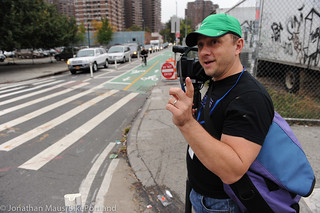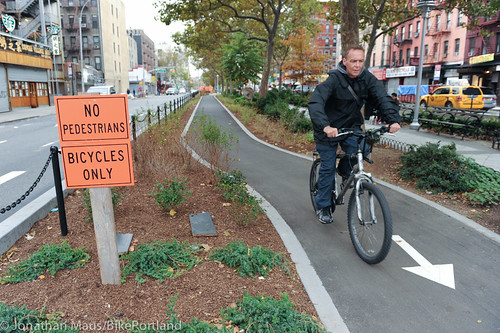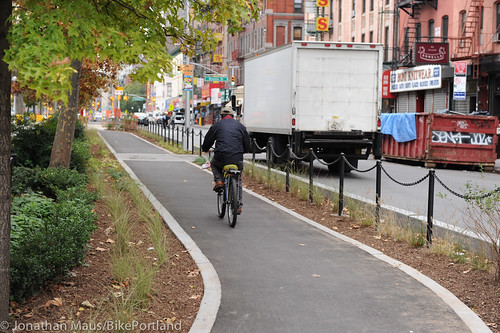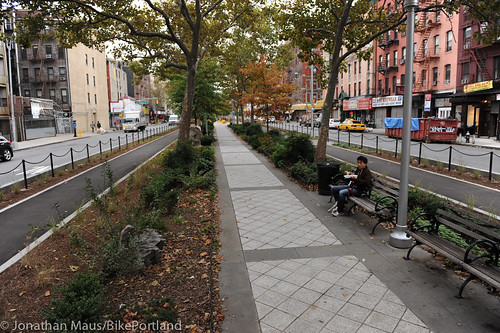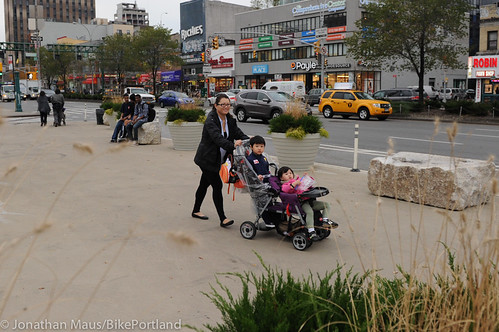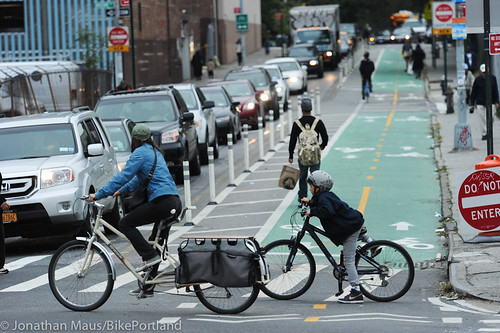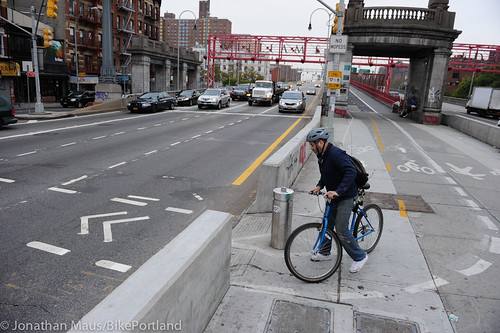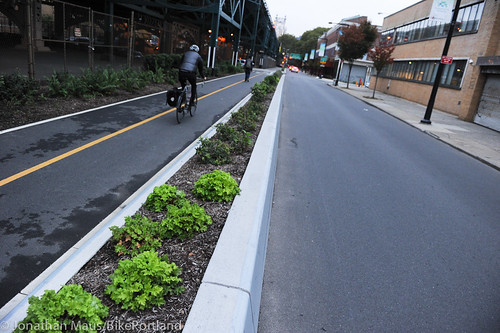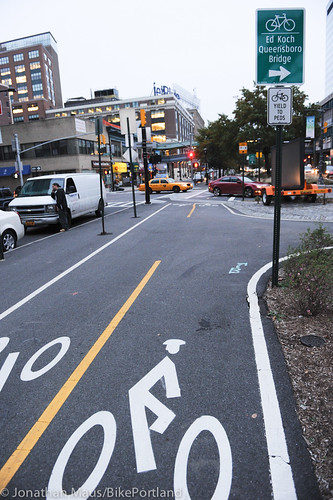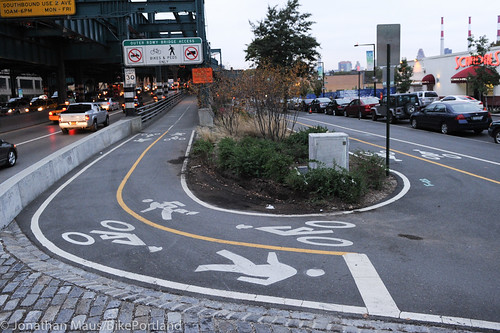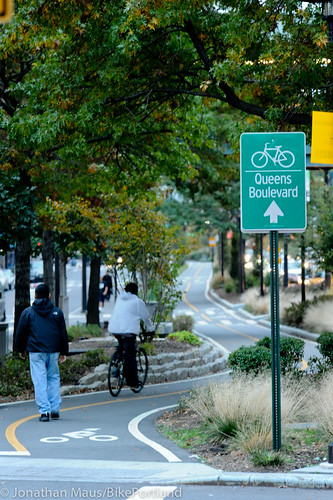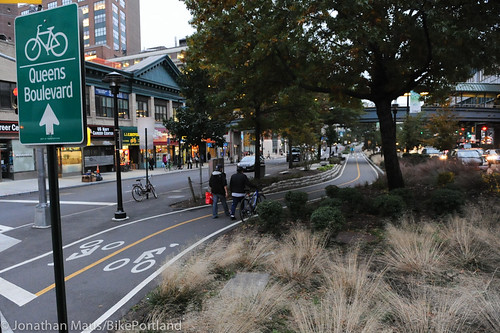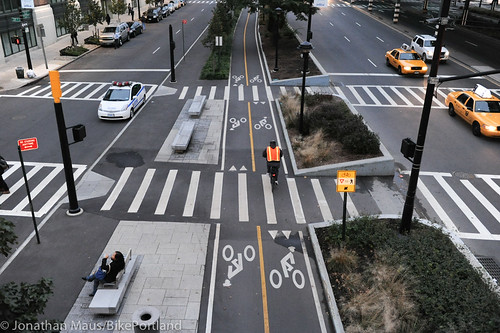
(Photos © J. Maus/BikePortland)
made possible by:
- Planet Bike
- Lancaster Engineering
- Readers like you!
Like some of you, I’ve been hearing and reading about the “streets renaissance” going on in New York City for several years (thanks in large part to the coverage on Streetsblog and Streetfilms). Yesterday I got my first chance to see it for myself.
My impression? It’s even better than I thought.
Thanks to an impromptu tour led by Streetfilms’ Clarence Eckerson (a man whose films I’ve relied on as a window into New York City’s progress for the past six years), I got to see several of the NYC Department of Transportation’s streetscape projects.
As we walked around Manhattan, I saw roadway space being allocated to include bicycle access everywhere I looked: buffered bike lanes; green, curbside bike lanes; physically separated bike lanes; multi-use paths, and more. (And for walking, there were plazas, abundant striped crosswalks, median islands, curb extensions, and more.) And there was a wide mix of people of using the bikeways; from workers on delivery bikes to families to fixed gear daredevils, fashion-conscious women, and more.
When a woman like this feels comfortable biking on one of New York City’s busy intersections with a skateboard in a basket and an iPhone in her hand, you know they’re doing something right…
On 1st and 2nd Avenues (a major north/south couplet), NYCDOT transformed wide, auto-centric streetscapes into streets with “select bus service” where buses have a dedicated, priority lane; and protected bike lanes.
At one point as we crossed a street, Clarence noticed a new, bright-green colored bike lane. “Oh, hey, where’d that come from?!” he exclaimed. It seems they are implementing new bikeways faster than even local activists can keep up.
On nearby Allen Street, NYCDOT has transformed what was once a neglected and narrow center median — between two-way, high-volume, high-speed roads full of cars — into an oasis with protected bike lanes running adjacent to it on both sides.
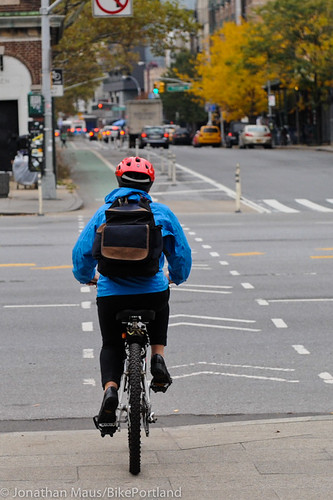
Allen Street was interesting because it shows how NYCDOT is already improving on their improvements. For several blocks the center median has parallel, green-colored bike lanes separated by plastic bollards. Then further north, Clarence showed me the latest evolution of Allen Street. Instead of just the colored bike lanes, NYCDOT has widened the center median and created what reminds me of the Park Blocks in Portland. There’s a walking path in the middle lined with new benches and artwork, and a biking-only path on the outer edge. Public art and lots of newly planted trees and gardens abound.
Heading east, we walked along Delancey Street, a major feeder route onto the Williamsburg Bridge. In one of their very recent intersection makeovers, NYCDOT has created large public spaces smack dab in what used to be travel lanes. Where cars once ruled in the margins of this large arterial, now a group of teens sits on a large boulder, and a woman with two young kids pushes a stroller.
At Clinton Street (near the bridge entrance), newly green-colored, separated bike lanes feed into Delancey up onto the bridge’s biking and walking path (which runs in the center of the bridge).
As a steady stream of people on bikes streamed by us, we just sat there, taking it all in. The intersection was humane, crossing distances were shortened with bulb-outs and generously zebra-striped crosswalks, feeder bikeways from all directions led intuitively up onto the bridge path. It’s not perfect (DOT Commissioner Sadik-Khan is known to “tweak” designs as needed); but it’s a fantastic transformation that should excite anyone who cares about traffic justice and safety.
Continuing over to Queens Plaza North, Clarence pointed out where NYCDOT expanded a narrow, relatively unused sidewalk under the Queensboro Bridge into a two-way. grade-separated cycle-track and walking path.
The path connects directly up onto the bridge, and there are small bike chevrons to let folks know where to ride.
At Crescent Street, the bikeway turns into a dedicated path that runs through what feels like a park. When you stop and think that people are riding and walking in what used to be a huge parking lot, it really is breathtaking.
In just a relatively short walk, I was able to easily see the reality behind all the talk and hype I’ve heard about for the past five years. It surpassed my expectations, and I can’t wait to get out there and see more of it. Stay tuned.
— This post is part of my ongoing New York City coverage. I’m here for a week to cover the NACTO Designing Cities conference and the city’s bike culture in general. This special reporting trip was made possible by Planet Bike, Lancaster Engineering, and by readers like you. Thank you! You can find all my coverage from this trip here.


